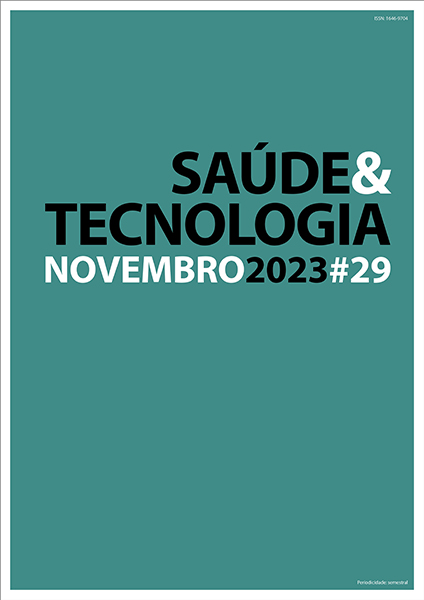Adaptação de lente escleral em doente após queratoplastia penetrante (PKP) com astigmatismo e anisometropia elevada
DOI:
https://doi.org/10.25758/set.586Keywords:
Queratoplastia penetrante (PKP), Astigmatismo irregular, Anisometropia, Lentes esclerais, Leucoma, InflamaçãoAbstract
A reabilitação visual após queratoplastia penetrante (PKP) é a principal indicação para aproximadamente 15% de todas as adaptações de lentes esclerais e um astigmatismo irregular significativo está presente em 62,9% dos doentes após esta técnica. As lentes de contacto (LC) podem melhorar a função visual nestes doentes, especialmente as lentes esclerais (SL), uma vez que a lente é muito estável e pode ultrapassar a interface enxerto-hospedeiro, minimizando a potencial irritação mecânica relacionada com o movimento ou suporte da lente, reduzindo o potencial de rejeição ou falha do enxerto e corrigindo o astigmatismo corneano irregular elevado. Outra indicação da lente de contacto é a correção monocular após a PKP devido à anisometropia e aneisoconia normalmente presentes após esta técnica. A combinação destes dois fatores leva ao sucesso e à indicação da adaptação deste tipo de lentes de contacto nestes casos complexos. Este é um estudo de caso de um paciente com queratocone, que sofria de astigmatismo irregular, anisometropia elevada e leucoma generalizado após uma infeção monocular após PKP, com os principais objetivos de melhorar a acuidade visual corrigida (BCVA) e reduzir a aniseiconia com SL.
Downloads
References
Kumar M, Shetty R, Lalgudi VG, Vincent SJ. Scleral lens wear following penetrating keratoplasty: changes in corneal curvature and optics. Ophthalmic Physiol Opt. 2020;40(4):502-9.
Wietharn BE, Driebe Jr WT. Fitting contact lenses for visual rehabilitation after penetrating keratoplasty. Eye Contact Lens. 2004;30(1):31-3.
Kumar M, Shetty R, Khamar P, Vincent SJ. Scleral lens-induced corneal edema after penetrating keratoplasty. Optom Vis Sci. 2020;97(9):697-702.
Culbertson WW, Abbott RL, Forster RK. Endothelial cell loss in penetrating keratoplasty. Ophthalmology. 1982;89(6):600-4.
Lass JH, Benetz BA, Gal RL, Kollman C, Raghinaru D, Dontchev M, et al. Donor age and factors related to endothelial cell loss 10 years after penetrating keratoplasty: Specular Microscopy Ancillary study. Ophthalmology. 2013;120(12):2428-35.
Javadi MA, Feizi S, Yazdani S, Mirbabaee F. Deep anterior lamellar keratoplasty versus penetrating keratoplasty for keratoconus: a clinical trial. Cornea. 2010;29(4):365-71.
Barnett M, Lien V, Li JY, Durbin-Johnson B, Mannis MJ. Use of scleral lenses and miniscleral lenses after penetrating keratoplasty. Eye Contact Lens. 2016;42(3):185-9.
Fujita A, Yoshida J, Toyono T, Usui T, Miyai T. Severity assessment of acute hydrops due to recurrent keratoconus after penetrating keratoplasty using anterior segment optical coherence tomography. Curr Eye Res. 2019;44(11):1189-94.
Sung MS, Choi W, You IC, Yoon KC. Factors affecting treatment outcome of graft infection following penetrating keratoplasty. Korean J Ophthalmol. 2015;29(5):301-8.
Suarez C, Madariaga V, Lepage B, Malecaze M, Fournié P, Soler V, et al. First experience with the ICD 16.5 mini-scleral lens for optic and therapeutic purposes. Eye Contact Lens. 2018;44(1):44-9.
Zemba M, Stamate AC. Glaucoma after penetrating keratoplasty. Rom J Ophthalmol. 2017;61(3):159-65.
Walker MK, Pardon LP, Redfern R, Patel N. IOP and optic nerve head morphology during scleral lens wear. Optom Vis Sci. 2020;97(9):661-8.
Downloads
Published
Issue
Section
License
Copyright (c) 2024 Saúde e Tecnologia

This work is licensed under a Creative Commons Attribution-NonCommercial-NoDerivatives 4.0 International License.
The journal Saúde & Tecnologia offers immediate free access to its content, following the principle that making scientific knowledge available to the public free of charge provides greater worldwide democratization of knowledge.
The journal Saúde & Tecnologia does not charge authors any submission or article processing charges (APC).
All content is licensed under a Creative Commons CC-BY-NC-ND license. Authors have the right to: reproduce their work in physical or digital form for personal, professional, or teaching use, but not for commercial use (including the sale of the right to access the article); deposit on their website, that of their institution or in a repository an exact copy in electronic format of the article published by Saúde & Tecnologia, provided that reference is made to its publication in Saúde & Tecnologia and its content (including symbols identifying the journal) is not altered; publish in a book of which they are authors or editors the total or partial content of the manuscript, provided that reference is made to its publication in Saúde & Tecnologia.







